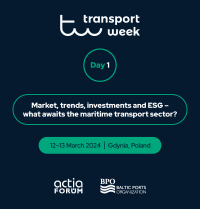Overview
Despite the presence of a military coalition in the Red Sea to combat attacks by Yemen-based Houthi
rebels on freight ships, the global supply chain remains under pressure. While global supply chains have
become materially more dynamic over the last few years, trade through the Red Sea represents an
estimated 40% of Asia-European trade including fuel, energy, food products, and manufactured goods
and remains a critical shipping link.
We expect the multinational maritime coalition, led by the United States and including the United
Kingdom, Bahrain, Canada, France, Italy, the Netherlands, Norway and Spain, will ultimately be effective
in addressing security challenges in the region related to freedom of navigation; however, disruptions
may persist over an extended period. Given the uncertainty of the situation, many global shippers are
actively rerouting cargo ships through the Cape of Good Hope, which extends transit times, increases
transportation costs, and creates strains on the global supply chain. The effects of increased shipping
times and, consequently, reduced vessel availability may be further amplified by increased shipping
demand before the extended closure of factories due to the Lunar New Year celebrations in China
(February 10, 2024).
While disruptions to the global supply chain in the Red Sea have and will continue to negatively affect
consumers and enterprises around the world, logistics providers have become far more agile over the
last several years and are in a much stronger operating position to navigate the current situation. Having
said that, we anticipate a range of credit impact outcomes on industries around the globe related to
their geographic footprint, customer base, nature of the product offering, complexity of their supply
chain, and product lead times.
Although a protracted conflict would risk a greater unfavourable credit impact, broadly speaking we
view the situation as modestly supportive for the air and sea cargo industry, broadly neutral for the
capital goods manufacturers and autos (with the exception of Chinese electric vehicles (EVs) and some
select European-based EV manufacturers), and modestly negative for retailers.
Global Retailers - Modestly Negative
Vessel delays and rerouting associated with the Red Sea crisis could at least temporarily have a direct
negative effect on inventory levels of some products for retailers in both Europe and North America. We
expect any effects on inventories to be more pronounced as it relates to bulk furniture and appliances as
well as mass market apparel and general merchandise. These are all product categories that are largely
manufactured in Asia and, unlike some more luxury goods, cannot be shipped economically via air cargo.
Global furniture retailer IKEA as well as UK fashion retailer Next PLC have already cautioned on product
availability, while Tesco indicated that the UK grocer is less affected than other retailers.123 We expect
effects on inventories to be more significant on smaller retailers with more concentrated supply chains
than on larger retailers that have a well-diversified global supplier base. Direct effects on inventories
aside, increased shipping times are likely to drive up freight costs across the supply chain. This has the
potential to not only negatively affect some retailers’ operating margins but could also hamper the pace
of disinflation, which could further exacerbate pressures on already strained consumer purchasing
power.
Capital Goods - Neutral
The complex supply chain processes of capital goods companies are heavily dependent on shipping by
sea. We expect vessel delays to increase general shipping costs and related surcharges, some of which
may not be transferred to customers. Detours add pressure to the recovery of the sector from prolonged
supply chain disruptions caused by (among other factors) the Coronavirus Disease (COVID-19) pandemic
and the Russia-Ukraine war. Capital goods manufacturers have been exploring changes in sourcing and
establishing production capabilities closer to where there is large customer concentration or stronger
growth prospects. While reshoring or nearshoring reduces risk from disruptions, however, the nature of
the products keeps the sector exposed to major shipping routes such as the Red Sea to access diverse
input materials and semifinished components. Prolonged disruption could compound into some
operating profit and cash flow pressure, but not without remedial action by the issuers, including
negotiating carrier rates and rerouting orders. While some inefficiencies are expected in the capital
goods sector, the industry has grown agile after three years of supply chain bottlenecks.
Automotive Manufacturing - Neutral
Regarding Autos, we note that while car carriers originating from Asia en-route to Europe are being
diverted, this nonetheless represents a nominal proportion of the total affected cargo. That being said,
there are certain niches of the auto sector that are being adversely affected by the Red Sea disruption,
most notably the export of EVs from China to Europe. With the domestic Chinese EV industry having
excess capacity and the major North American market having restrictive trade barriers regarding
Chinese-sourced EVs, Europe currently represents a key targeted export market for the Chinese original
equipment manufacturers (OEMs). In 2022, more than 500,000 vehicles were exported from China to
Europe, of which approximately 63% were EVs (with such proportion estimated to progressively increase
going forward). With older transport vessels being subject to scrapping during the coronavirus
pandemic, the Red Sea disruption represents a further strain on vessel supply logistics.
The impact of the Red Sea disruption on Automotive production is, for the time being, very limited.
Regarding major OEMs that have publicly commented on the matter, Volkswagen AG (rated A (low) with
a Stable trend), has indicated that it does not expect significant associated production impacts.
1 https://www.cnbc.com/2023/12/21/houthi-attacks-in-red-sea-ikea-warns-of-product-delays.html
2 https://www.reuters.com/business/retail-consumer/red-sea-attacks-could-moderate-growth-uks-next-says-ceo-2024-01-04/
3 https://www.bloomberg.com/news/articles/2024-01-11/red-sea-shipping-crisis-could-reignite-inflation-warns-tesco
Additionally, Stellantis NV (rated BBB (high) with a Stable trend) has stated that it is relying on air
freight to help cope with any temporary parts supply disruptions. Two exceptions to the above are Tesla
Inc. (Tesla) and Volvo Car AB (Volvo Car) (both of which are unrated by us) with Tesla and Volvo Car
having announced production stoppages of two week and three days, respectively, due to the Red Sea
Crisis. This is not surprising, as Tesla has meaningful production in China and Volvo Cars is majority-
owned by Chinese-based Geely Holding Group. As such, the impact of the Red Sea Crisis on the global
automotive industry is readily manageable for the time being, although other OEMs could also become
eventually affected should the crisis prove protracted.
Sea Cargo - Modestly Supportive
Recent disruptions to the shipping trade routes through the Red Sea have resulted in an increase in sea
vessel shipping rates. According to the Drewry's World Container Index, rates increased by 15% to USD
3,072 per 40-foot container (USD/40 feet) the week of January 11, 2024, up dramatically from USD 1,384
(USD/40 feet) the week of November 23, 2023. The extra time and distance associated with longer
shipping routes has enabled sea vessel shippers to utilize idled vessels and increase capacity utilization
(something that has been an issue recently) and is driving increased profitability for the industry in the
near term. However, in the longer term, we do not anticipate that the structural challenges the cargo
shipping sector was dealing with prior to the recent disruption will disappear. Therefore, while rates are
likely to remain elevated so long as access to the Red Sea is restricted, once global shipping returns to a
more normal operating environment, overcapacity due to excessive vessel investment, high global
customer inventories, weaker consumer spending due to cost-of-living pressures, and the nearshoring of
logistics networks are likely to pressure rates and profitability once again.
Air Cargo - Modestly Supportive
While global air cargo yields are expected to remain low in 2024 due to excess capacity and companies
look to nearshore their supply networks, the logistics challenges presented by the Red Sea disruption
could provide a modest tailwind to the sector. Given the relative discrepancy in the type of cargo
(material, state of matter, weight, size, flammability, etc.) that is usually shipped by air versus sea, the
two are not natural substitutes. Scan Global Logistics has noted that while an uptick in airfreight has
been visible, it has not been a tsunami-like surge in volume. Rather, we would anticipate that a slow,
steady impact on airfreight may occur, especially if a resolution takes months, rather than weeks.
Credit Impact of Red Sea Shipping Disruptions Vary by Industry | January 17, 2024










